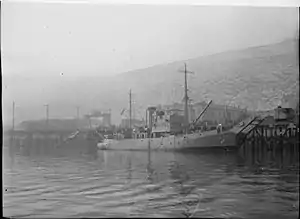 HMS Falconet | |
| Class overview | |
|---|---|
| Name | Net class |
| Builders |
|
| Operators | |
| Built | 1938–1939 |
| In commission | 1939–1958 |
| Completed | 11 |
| Lost | 1 |
| General characteristics [1] | |
| Type | Boom defence vessel |
| Displacement | 530 long tons (539 t) |
| Length | |
| Beam | 30 ft 6 in (9.30 m) |
| Draught | 9 ft (2.7 m) |
| Propulsion |
|
| Speed | 11.5 knots (21.3 km/h; 13.2 mph) |
| Complement | 32 |
| Armament | 1 × 3 in (76 mm) gun |
The Net class were a class of boom defence vessels of the Royal Navy and Royal Australian Navy during World War II.
Ships
Of the eleven ships of the class ten were built in shipyards in northern England and Scotland, while the eleventh was built in Sydney, Australia.[2][3] One ship, HMS Bayonet, was lost when it struck a mine in the Firth of Forth on 21 December 1939, probably laid by the U-21 on 4 November.[4]
Royal Navy
- HMS Bayonet (Z05)
- HMS Bownet (Z90)
- HMS Burgonet (Z33)
- HMS Dragonet (Z82)
- HMS Falconet (Z19)
- HMS Magnet (Z27)
- HMS Martinet (Z41)
- HMS Planet (Z50)
- HMS Plantagenet (Z63)
- HMS Signet (Z10)
- HMS Sonnet (Z47)
Royal Australian Navy
See also
References
- ↑ "Boom and harbour defence vessels" (PDF). godfreydykes.info. 2012. Retrieved 18 August 2012.
- ↑ Helgason, Guðmundur (2012). "Net class Boom defence vessels (UK)". uboat.net. Retrieved 18 August 2012.
- ↑ Helgason, Guðmundur (2012). "Net class Boom defence vessels (AUS)". uboat.net. Retrieved 18 August 2012.
- ↑ Helgason, Guðmundur (2012). "HMS Bayonet (Z 05)". uboat.net. Retrieved 18 August 2012.
External links
Wikimedia Commons has media related to Net class boom defence vessel.
This article is issued from Wikipedia. The text is licensed under Creative Commons - Attribution - Sharealike. Additional terms may apply for the media files.